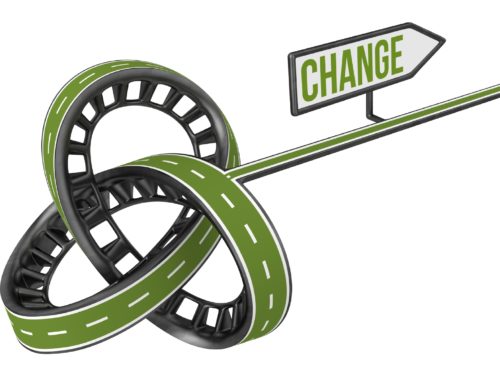“It isn’t the changes that do you in, it’s the transitions.”
-William Bridges
The Great Resignation, the Great Reset, the war in Ukraine, and even runaway inflation aren’t the entire story. There is an even bigger one, and it will affect every aspect of how you lead in the months and years to come. It is “The Great Transition.”
To create some context, William Bridges told us that every change has three basic parts:
- An ending when the old way is over.
- A transition period where there is a great deal of turmoil. Bridges calls this the Neutral Zone. I have written about it as the Messy Middle of change.
- A new beginning where the new way is familiar.
I wrote that we live in a perpetual state of transition in my book Make Change Work. The idea was that change occurs so quickly these days that we never reach a new beginning. This was based on the realization that the pace of change—barring a total world meltdown—is as slow as it will ever be in our lifetime.
But wait. There is more.
The continuous acceleration of change is only part of the problem. There are three additional factors that make The Great Transition an especially scary time.
- The rate of change. As we’ll discuss in a moment, tectonic shifts are occurring in six areas that affect how we live, work, and lead. The Pandemic didn’t create these shifts. It only accelerated them. The result is change overload where people and organizations are overwhelmed to the point of ineffectiveness. PROCI reported that 73 percent of respondents to a recent survey said that their organizations are at or near the point of being completely saturated with change.
- The endings aren’t visible and clear. Not every change has the clear ending Bridges described. The demise of check writing has been predicted since at least 2003, and yet billions of checks are still written each year. Millennials –a group you would expect to use predominantly digital payments – are as likely to write a check as use a mobile wallet.
- The pace of moving through these changes is uneven and unpredictable. There is no schedule for when the rate and pace of change will achieve a level of predictability. Each of them will occur at its own pace. They will be done when they are done … and perhaps not at all. That creates problems because our brains crave certainty just as they desire other primary needs like food or sex. The result is anxiety, stress, and endless “what if” games consuming our thoughts.
Six Simultaneous Shifts
Alfred Wegner, a German meteorologist and geophysicist, noticed that the maps of South America and Africa would fit like the pieces of a puzzle if you could remove the Atlantic Ocean. His observation, though initially ridiculed, became the theory called Continental Drift. This later evolved into what we now call Plate Tectonics. The theory states that the Earth’s rigid outer crusts continuously shift in plates floating on the molten upper portion of the mangle. These plates—which we know as continents—move at different rates relative to each other. They are always coming together or spreading apart.
The six shifts that make up the Great Transition are:
- The birth rate in the United States continues to be below the replacement rate. Baby Boomers are no longer the dominant generation in terms of numbers, but they remain a force in terms of financial position. The nation is diversifying, as well. The number of Americans identifying as “White” fell from 63.7 percent in 2010 to 57.8 percent in 2020.
- Migration: A Pew Research study reported that more people lived outside the country of their birth in 2015 than ever before. The 281 million migrants in the world represents a small percentage (6 percent) of the population, and COVID-19 slowed the migration rate down. The United States has been the main destination for international migration since 1970. The ability of the U.S. to effectively manage migration affects the economy and the society.
- Political polarization that creates instability. Political polarization could easily be designated as an effect created by demographic, migration, and economic shifts rather than its own cause of disruption and change. I list it separately for on important reason: The choices that determine our ability to flourish as a society require cooperation and collaboration with those who have a different view. The political debate is mostly controlled by partisans on the left and right Roughly 90 percent of Trump and Biden supporters in the 2020 Presidential election believed that a victory by the opponent would cause lasting harm to the United States.
- Values shifts: The values Americans view as important have changed dramatically over the past 20 years. Younger Americans view patriotism, religion, and marriage as much less important than the generations that came before them. Another study found that 65 percent of adults believed that people become rich because they had more advantages in life. The same study reported that 71 percent believe that people are poor because they faced more obstacles. These value shifts can be attributed to generational, migration, and political change. They do, however, point to an important transition in how our organizations and institutions work.
- Geopolitical risks: Russia’s invasion of Ukraine is the dominant factor as of this writing. Every indication is that this war will alter the energy and economic dynamics in the West for years to come regardless of the war’s outcome. It is far from the only geopolitical risk faced by the world. China’s Belt and Road Initiative and its relationship with Taiwan threaten global economies. Likewise, the Middle East continues to be a ticking time bomb that explodes when we least expect it. All of these threaten world stability and security. Most important, they make reevaluating our alliances crucial.
- Technology-driven Innovation: Technology has always been a driver for change and disruption. Humans, likewise, have also wondered if new innovations would be anything more than a novelty. Mark Mills, a Manhattan Institute senior fellow and faculty fellow at Northwestern University wrote, “Technology matters because it improves humanity’s ability not only to survive … but to do so more easily. It is the most power way to improve productivity.” The convergence of information, machine capacity, and materials will open the door to innovation in every area of our lives and, potentially, help us address demographic changes that are underway.
Any one of these changes would be important. That they are all happening at once ranks as a once every lifetime scenario.
What It Means for Leaders
Are we destined for the dystopian collapse that Umair Haque warns is possible? Can we get out of our own way, or are we doomed to continue our downward spiral as Jessica Wildfire suggests?
Even optimists can agree that the Great Transition is messy, uncomfortable, and scary. It is also the time when the best leaders will shine. Unfortunately, there is not much evidence that leaders are up to the task.
The first step in working our way through this is to acknowledge reality while respecting the past. Nothing ever changes until people tell themselves the truth. Leadership — at least the way it is traditionally practiced — broken. The strict hierarchies, inflexible goals, and protecting the status quo are only marginally effective today. They will be even less so in the future.
The leadership change we need must also respect the past if we want to bring others with us. Everything that frustrates us about how our organizations and institutions operate today was once—probably 15 to 20 years ago—someone’s honest attempt to solve an important problem.
Beyond that, we need leaders and leadership to transform for the new reality. Here are seven places to begin.
- From power based on position to influence based on relationships and trust. The teacher, mentor, or coach who most influenced you had high expectations. You willingly worked to exceed them because of their relationship with you not their position. The best leaders have always known this. Now it is the minimum expectation for any leader who wants to be effective.
- From activity focused to results focused. There are absolutely jobs that require people to be in a specific place at a specific time. That will not change. What must change is the idea that the schedules people keep are more important than the results they produce. Micromanagement creates friction that leads to mistrust.
- From making the organization successful to making everyone successful. The days of organizational success at the expense of broader stakeholder success are over. People are weary of being second-class citizens in the quest for organizational or institutional gain.
- From protecting the status quo to building the future. Past success means that you were once right. The best organizations actively manage and lead to their desired future. Every leader, regardless of their level, must avoid the Seven Last Words of Every Organization: We’ve never done it that way before.
- From compliance driven to values led. You can mandate compliance. People volunteer their commitment. They do that more often when leaders make shared values come to life in every action and decision.
- From leadership by a few to leadership by everyone. Leadership is about the ability to influence the actions and outcomes of others to achieve desired results. It is nothing more, and it is nothing less. The team member who quietly undercuts new ideas or improves efficiencies is just as crucial to your success as the person with a leadership title. You still need structure, and we also need leaders leading and growing other leaders.
- From linear to dimensional. We teach leadership in series of prescribed steps and levels. It no longer works that way. The successful leader of the future will seamlessly and simultaneously operate within interconnected dimensions.
-
- Personal leadership to build credibility and trust
- Interpersonal leadership to create connection
- Organizational leadership to ensure effectiveness and efficiency
- Developmental leadership to help team members grow and the organizational continually improve
- Change leadership to continuously anticipate, pursue, and adapt to the future
- Transformational leadership to remake the organization and team when needed
Mastering these Six Dimensions of Leadership™ allows the leader to execute flawlessly today, prepare for the challenges of the future, and respond to the uncertainty of both.
Change no longer influences the environment. It is the environment. The Great Transition is not going away. We need new leaders … or even old leaders who are willing to learn new ways. The job is to inspire and influence a shared culture that continuously challenges the status quo to remain relevant. That is the only way we come out of this prepared to flourish.
Randy Pennington helps leaders and organizations deliver positive results in a world of uncertainty and change. He is an award-winning author, speaker, and self-described organizational nerd. e. To learn more or to engage Randy for your organization, visit www.penningtongroup.com, email info@penningtongroup.com, or call 972–980–9857 (U.S.).
This article was first published on the Medium platform.




